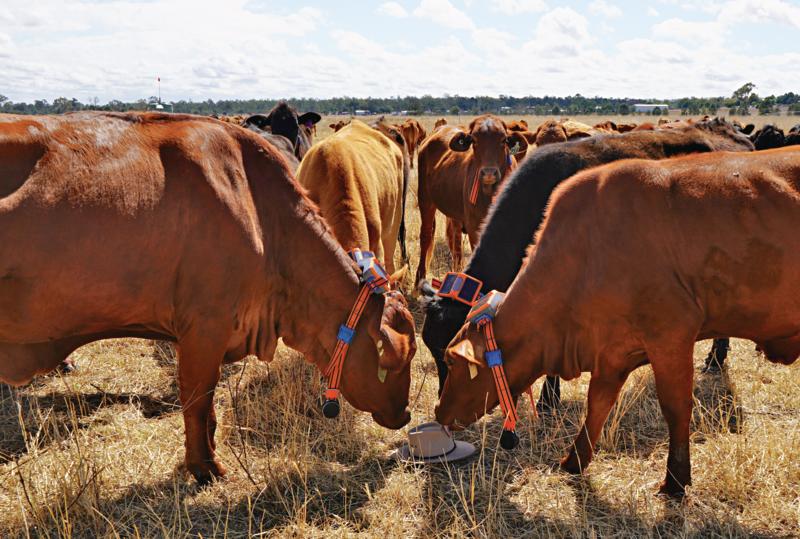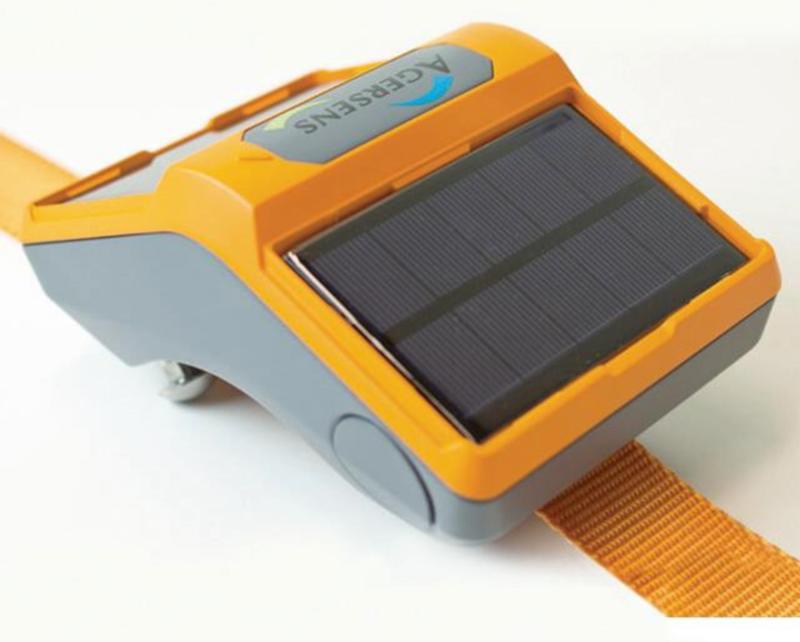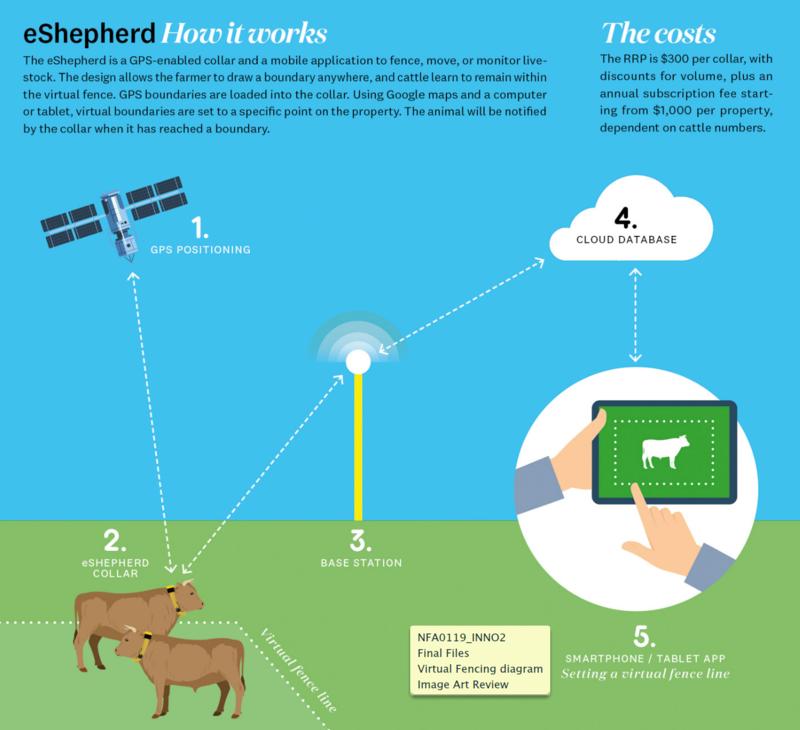THE potential uses of virtual fencing are limited only by a farmer’s imagination. However, the technology is still being fine-tuned and legislation regulating its introduction is still a hurdle in some states, including NSW.
Virtual fencing is a system that enables livestock to be confined or moved without using fixed fences, instead relying on collars, sensors and wireless technologies. The CSIRO started research and development (R&D) into virtual fencing in 2005, and now works in partnership with Melbourne-based agritech start-up Agersens to develop on-farm applications for the technology. Its first product, the eShepherd for dairy and beef cattle, is now being rolled out commercially.
Agersens markets the eShepherd system, which it developed using CSIRO research, as the world’s first livestock virtual fence. It uses solar-powered collars incorporating GPS tracking devices, and allows farmers to set virtual boundaries using a computer, laptop or smartphone.
Animals are given an audio warning if they approach the perimeter and feel an electric pulse if they continue – one far lower than contacting an electric fence. Initial research determined whether cattle could learn to respond to the cues. It also examined how loud the audio needed to be and how strong to make the electric pulses, to minimise the animals’ stress.
 The eShepherd solar-powered cattle collar at work on the farm. Supplied by: eShepherd.
The eShepherd solar-powered cattle collar at work on the farm. Supplied by: eShepherd.
The CSIRO is continuing to work with Agersens on R&D, and is one of the organisations receiving funding to investigate different aspects of virtual fencing under the ‘Enhancing the profitability and productivity of livestock farming through virtual herding technology’ project. This four-year project is funded through the federal Department of Agriculture and Water Resources as part of its Rural R&D for Profit Program.
CSIRO research scientist Dr Dana Campbell says small trials are now looking at the role of group learning in stock. “Our aim is to define the applications and limits of the technology and come up with recommendations on things like how often you can move the fence before confusing the animals,” Dr Campbell says.
“We already know some cows learn faster than others and most individuals learn to avoid the virtual fence in 24-48 hours. But they’re herd animals, so we need to examine the group dynamic. When there’s a group, some individuals don’t approach the boundary as often.”
“Welfare issues have always been at the forefront of our research and we’re continuing to look at short and longer-term effects of using the collars. Electric fences are widely accepted but this is relatively new and our data will continue to inform the public and regulators.”
Queensland and Tasmania are the only states that freely allow the sale and use of virtual fencing technology. In other states, it’s largely restricted to research trials. In NSW, for instance, the Prevention of Cruelty to Animals Act 1979 details specific electrical devices that may be used on animals. A review is currently underway to modernise animal welfare regulations, which many hope will take the technology into account.
 A close-up of the eShepherd solar-powered cattle collar. Supplied by: eShepherd.
A close-up of the eShepherd solar-powered cattle collar. Supplied by: eShepherd.
While it may take some time before all farmers get unlimited access – and for the technology to develop far enough – farmers have a shopping list of ideas about how they could use virtual fencing.
Researcher Nikki Reichelt is leading a University of Melbourne project that includes engaging with farmers about the opportunities they see, as well as the challenges to be solved. “We held workshops with northern beef producers, southern beef producers, dairy farmers and sheep producers in 2017, and it’s clear they considered virtual fencing could be much more than a simple replacement for physical fences,” Nikki says.
“Initial benefits included knowing the real-time location of livestock, being able to control their movements for rotational or strip grazing, excluding them from riparian zones or areas prone to erosion, and mustering with less labour. But farmers eventually wanted a holistic animal management system which captures livestock activity patterns, monitors health, shows when they’re on heat and their breeding habits and matches calves and cows.”
Reliability was number one – having the technology work well the first time – and farmers also wanted a clear understanding of the upfront investment required. Animal welfare was another key consideration for the farmers in the workshops.
“They weren’t concerned about the electric pulse being emitted, once it was explained, but wanted to make sure the collar wasn’t going to become a choking hazard or cause skin damage by rubbing,” Nikki says.
“Farmers commented that it was vital to develop clear and strong messages to explain the technology to the general public so there was less chance of misconceptions about how it impacts the welfare of livestock. This would help in maintaining a farmer’s social licence to operate.”
The governance of the data collected also raised questions. “Who owns the data and who can access it, in what form? How much internet and satellite connectivity is needed for the collars to work, and what support is there to fit and maintain them?” Nikki says. “It was also clear farmers would like to see smart farming technologies such as virtual fencing becoming integrated with other solutions to support whole-farm systems decision making, rather than operating independently.”
 How the eShepherd system works.
How the eShepherd system works.
For sheep producers, the technology is still some way off. They want ear tags rather than collars, partly because wool gets in the way of the electric pulse.
Agersens CEO and founder Ian Reilly says R&D is constantly being done to improve the offering. “Once the boundary is set in the collar, internet connectivity isn’t needed to maintain operation, as GPS tracking is done using satellites that are freely available everywhere,” Ian says. “The collars will get smaller as solar power and battery technology improve and more sophisticated uses will be available as we get more accurate GPS and as the behavioural work gathers more data.”
Ultimately, Ian believes there are uses for the technology well beyond the paddock. “Controlling grazing patterns can protect new growth and riparian zones and increase productivity,” he says. “Mixed farmers have increased flexibility to graze paddocks usually used for cropping. Rangeland producers can track their herd and even muster them without stress by gradually tightening the boundaries. But just think about the stories of provenance you will be able to tell, once you can legitimately say ‘this cow has only ever grazed in this paddock’ or track a lifetime of health and habits. It will open up a whole new realm of traceability.”
RELATED ARTICLES ON INNOVATIVE FARMING TECHNOLOGY:
-
Floating solar panels on farm dams set to cut energy costs
-
Christmas tree farmer boosts business with space-age machine
-
Clever silo storage helps grain farmer harvest top dollar
-
Bucking tradition breeds innovation for Merino sheep farmer
THE BENEFITS OF VIRTUAL FENCING
- Productivity and profitability through improved feed use and better matching of animal demands to feed supply and quality.
- Improved environmental and sustainability outcomes such as reduced overgrazing and better weed control and nutrient management.
- Improved labour efficiencies and reduced capital investment in fencing.